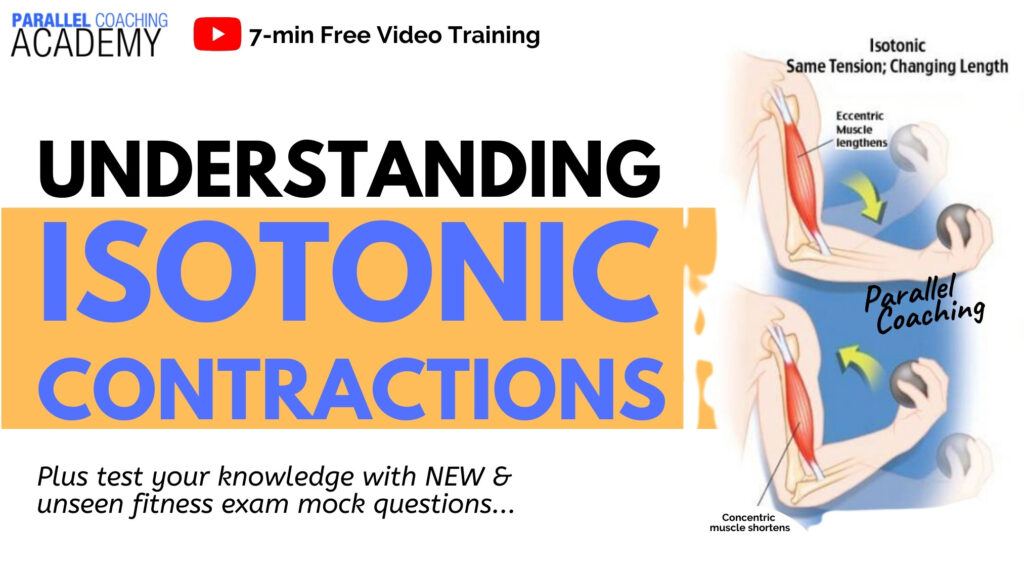This video and blog will teach you all about Isotonic contractions, and 5 clear steps to breaking down any exercise to work out the isotonic muscle contractions. You’ll also learn the difference between isometric and isotonic contractions.
You will need to know this for your Level 2 and Level 3 Anatomy exams, as well as when programming exercises for your clients.
At the bottom of this blog, you’ll also find three mock questions to test your knowledge
Watch the 7-minute video about Understanding Isotonic Contractions
The difference between Isometric and Isotonic contractions:
Both Isometric and Isotonic are types of muscle contractions. However they are very different
ISOMETRIC contractions are when a muscle is contracting, but stays the same length, for example in an iso-squat or plank-hold. A good way to remember this is that the muscle is staying the same length throughout the movement.
Iso = same, and Metric = length. Therefore Isometric = same length.
ISOTONIC contractions are when muscles contract whilst lengthening and shortening. The muscle has the same tone throughout the movement but will change length, creating a joint action. This is the most common type of muscle contraction
Iso = same, and Tonic = tone. Therefore isotonic = same tone (but moving)
Isotonic contractions are made up of Concentric and Eccentric Contractions.
Under the heading of isotonic, the muscle can be either lengthening or shortening. There are anatomical names for this.
Concentric contraction = The muscle is contracted but shortening
Eccentric Contraction = The muscle is contracted but lengthening
Whenever a joint action takes place in an exercise, there will be both concentric and eccentric contractions of a muscle.
This occurs in the prime mover muscle.
Isotonic contractions in a Biceps Curl:
Let’s take a dumbbell biceps curl.
When lifting the dumbbell towards the shoulder, you are shortening the biceps brachii via a concentric contraction.
When lowering the dumbbell towards the flow, you are lengthening the biceps brachii via an eccentric contraction.
It is important to understand that both the concentric and eccentric contractions both occur in the prime mover, which in this case is the Biceps Brachii. The antagonist muscle (Triceps Brachii) remains relaxed, not contracted, throughout the entire movement. If you want to learn more about Agonist/ Anatognist muscles see this blog and video: HERE
Understanding Isotonic contractions in exercise
There are 5 clear steps to breaking down any exercise and working out the isotonic muscle contractions
- Choose an exercise that has joint actions (keep it simple) – so not an isometric movement
- Work out the Concentric phase of the movement. This is when the load is moving toward the Clouds,
C = Concentric C= Clouds. - In the Concentric phase what Joint actions are taking place.
- What muscles are shortening to create those joint actions. THese are the prime movers of that movement/exercise.
- Do a few repetitions and feel that the prime mover is concentrically and eccentrically contracting.
Understanding Isotonic contractions in a squat
Let’s use these 5 steps in the example of a squat:
- Choose an exercise that has joint actions = Squat
- Work out the Concentric phase of the movement. = The lifting phase when standing up
- In the Concentric phase what Joint actions are taking place. = Knee extension and Hip Extension
- What muscles are shortening to create those joint actions. THese are the prime movers of that movement/exercise. = Quadriceps and Gluteus Maximus
- Do a few repetitions and feel that the prime mover is concentrically and eccentrically contracting. Have a go yourself to feel the action
In summary
An Isotonic contraction involves movement. The muscle stays the same tone throughout the movement but changes length via concentirc and eccentric contractions.
Test your knowledge with three mock questions:
[NOTE: The answers are below the 3rd questions]
Q1: What type of muscle contraction happens during a plank-hold?
A. Isotonic
B. Isometric
C. Concentric
D. Eccentric
Q2: During a Dumbbell Biceps Curl, which is true during the eccentric phase?
A. The Biceps Brachii Eccentrically contracts
B. The Triceps Brachii Eccentrically contracts
C. The Biceps Brachii Concentrically contracts
D. The Triceps Brachii Concentrically contracts
Q3: During a Dumbbell Shoulder Press, which is true during the concentric phase?
A. The Deltoids and Triceps Eccentrically contract
B. The Deltoids and Triceps Concentrically contract
C. The Deltoids and Triceps Isometrically contract
D. The Latissimus Dorsi Eccentrically contracts
Answers to the mock questions are :
Question 1= B, Question 2 = A, Question 3 = B
If you want more mock questions like this, then you can download more Free Mock Questions: DOWNLOAD NOW
Need More Help with your Level 3 Anatomy Revision?
For Trainee FITPROS Taking Their L3 Anatomy & Physiology Exam.
Learn, Revise & Pass Your Level 3 Anatomy & Physiology Exam In Under 10-hours
(Without Having To Spend Hours Revising Or Feeling Overwhelmed)
If you want to get your revision structured, learn everything you need to know, and feel confident on exam day, then click the link below:

Dedicated to More
Hayley “Understanding Isotonic Contractions” Bergman
Parallel Coaching
P.S. You can also find us on the following platforms:
Instagram: Follow Now
Facebook: Like Our Page
Twitter: Tweet Us
YouTube: Subscribe Here
More Muscles Blogs: HERE

